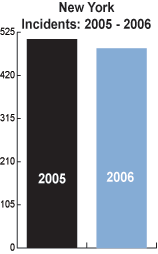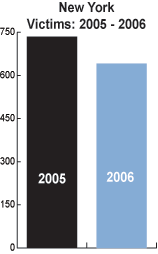The 2006 data showed that there were 486 incidents reported in the region, down 4% from 2005. There was also a 13% decrease in victims (from 735 to 641), and in a surprising, but positive development, the number of offenders dropped 16%, from 1,058 to 893. The substantial decline in offenders and the smaller decline in incidents were both reflected in the national trends discussed in the NCAVP report, which showed the number of offenders falling 13% and incident reports declining 3%. Nationally, the number of victims fell 9%.
Despite the declines noted in the data released today, representatives took care to note that cases in the New York City area jumped 26% in 2003; after a slight decline in 2004, a more significant one in 2005, and finally the additional decline in 2006, reports are still up almost 10% from just four years ago.
"Last year, we were hopeful that the large fall in reports was the front-end of a real trend; however, it's clear that like the nation overall, any decrease in rates of anti-LGTB violence slowed dramatically in 2006," said Clarence Patton, the Anti-Violence Project's executive director. "There is fortunate news in the data that indicates that though the frequency of anti-LGTB violence really hasn't changed much, fewer individuals were victimized by it and fewer offenders participated in it last year," Patton continued.
"Of course, when we as an organization or a community respond to particularly heinous incidents such as the attack on Kevin Aviance and a number of other gay men in June, or the murder of Michael Sandy in October, we realize that the true measure of whether or not we've made progress in combating hate violence is whether or not these incidents are rare occurrences; it's clear from the data and from the continued experience of far too many LGBT people that we are far from reaching that point," said Patton.
"As we released our report last year, I noted that we are fortunate here in New York to be in an extraordinarily inclusive and diverse city, but that our diversity does not protect us from the waves of political, cultural and physical hatred and violence that swept across our country and so negatively impacted our community and families nationwide over the last several years. This remains true, and unfortunately, the inclusion we strive for here in New York only incites those who feel threatened by our vibrant communities. But we also know that our inclusion and diversity is much stronger than hate, and that one day violence based in that hate will be an anomaly, not the norm," Patton added.
Of particular note in the 2006 data collected by the Anti-Violence Project were
 a significant increase in murders: in
2005, the Anti-Violence Project worked on one case it considered to be a
hate-motivated, in 2006, there were 5.
a significant increase in murders: in
2005, the Anti-Violence Project worked on one case it considered to be a
hate-motivated, in 2006, there were 5.
 a 5% increase in female
victims
a 5% increase in female
victims
 a 9% increase in assaults in which
weapons were used, despite a 12% decrease in assaults overall
a 9% increase in assaults in which
weapons were used, despite a 12% decrease in assaults overall
"Over the last several years, some of our most the high-profile incidents involved African-American men such as Kevin Aviance and Michael Sandy and that's raised questions as to whether or not there is an increasing level of violence for gay men of African descent. The number of such victims rose 2% last year, however the number of African-American victims remained 27% higher in 2006 than in 2002. We know that part of that increase is the result of an improvement in our outreach to people of color communities resulting in more reports, but there is also a concern that must be noted that as LGTB people of color become more visible they may be becoming increased targets for violence in the same way that the LGTB community at-large has at times of high visibility."
Though the increase in reports from the Latino/a community has not been nearly as marked as that from the African-American community (reports from Latinos/as are only up 4% since 2002), Latinos/as comprise 31% of all victims in the New York area. Whites make up 35% of victims.
Finally, as in past years, the largest proportion of the cases reported to AVP (42%) occurred in Manhattan, though agency representatives pointed out that the victims in many of those cases came from all over the city and the Metropolitan Area. Another 19% of the incidents tracked by the Anti-Violence Project occurred in Brooklyn; 12% were in the Bronx, while 13% took place in Queens; 3% were on Staten Island; Another 4% occurred in unspecified locations around New York City, and 8% took place in New Jersey, Westchester or the Lower Hudson Valley.
___________
In 2006, the Anti-Violence Project served over 2,000
victims of violence. The Anti-Violence Projectís annual reports on hate and
domestic violence can be accessed online at http://www.avp.org/.
The New York City Gay & Lesbian Anti-Violence Project is the nation's largest service agency for victims of bias crimes against the lesbian, gay, transgender, bisexual, and HIV-affected communities. Since 1980, the Anti-Violence Project has provided counseling and advocacy for tens of thousands of survivors of bias-motivated and domestic violence, rape and sexual assault, HIV-related violence, and police misconduct. The Anti-Violence Project documents incidents of violence against and within LGTB communities, educates the public about the effects of violence, against or within our communities, and works to reform public policies impacting all lesbian, gay, transgender, bisexual, and HIV-affected people.
The Anti-Violence Project provides free and confidential assistance to crime victims through its 24-hour bilingual hotline (212-714-1141).
Selected illustrations from the New York report on anti-LGTB Hate Violence in 2006:


